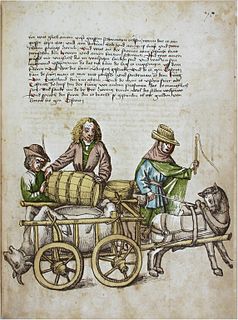 W
WLithuanian cuisine features products suited to the cool and moist northern climate of Lithuania: barley, potatoes, rye, beets, greens, berries, and mushrooms are locally grown, and dairy products are one of its specialties. Various ways of pickling were used to preserve food for winter. Soups are extremely popular, and are widely regarded as the key to good health. Since it shares its climate and agricultural practices with Northern Europe, Lithuanian cuisine has much in common with its Baltic neighbors and, in general, northern countries. Longlasting agricultural and foraging traditions along with a variety of influences during the country's history formed Lithuanian cuisine.
 W
WAspic is a savoury gelatin dish made with a meat stock or consommé, set in a mold to encase other ingredients. These often include pieces of meat, seafood, or eggs. Aspic is also sometimes referred to as aspic gelée or aspic jelly.
 W
WMajor beer scene of the Lithuania in the northern part of the country, centered around the towns of Pasvalys, Pakruojis, Kupiškis and Biržai. The farmhouse brews of the region are highly distinctive, using local ingredients and techniques from past generations. Lithuanian farmhouse beer has a soft, sweetish malty palate, hops do not dominate.
 W
WBigos, often translated into English as hunter's stew, is a Polish dish of chopped meat of various kinds stewed with sauerkraut and shredded fresh cabbage. It is served hot and can be enriched with vegetables, spices or wine.
 W
WA blini pl., diminutive: млинчики, mlynchiki) or, sometimes, blin, is a Russian pancake traditionally made from wheat or buckwheat flour and served with smetana, tvorog, butter, caviar and other garnishes. Blini are among the most popular and most-eaten dishes in Russia.
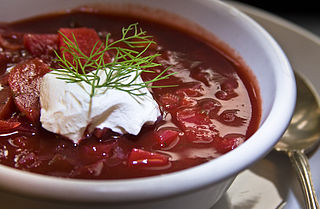 W
WBorscht is a beet soup common in Eastern Europe and Northern Asia. It is typically made with using large amount of beets, by combining meat or bone stock with sautéed vegetables, which – alongside with large amount of beetroots – may include cabbage, carrots, onions, potatoes and tomatoes. Depending on the recipe, borscht may include meat/chicken/fish or be purely vegetarian; it may be served either hot or cold; and it may range from a hearty one-pot meal to a clear broth or a smooth drink. Its popularity has spread throughout Eastern Europe and the former Russian Empire, and – by way of migration – to other continents. In North America, borscht is often linked with either Jews or Mennonites, the groups who first brought it there from Europe. Several ethnic groups claim borscht, in its various local guises, as their own national dish consumed as part of ritual meals within Eastern Orthodox, Greek Catholic, Roman Catholic, and Jewish religious traditions.
 W
WBublik is a traditional Eastern European bread roll. It is a ring of yeast-leavened wheat dough, that has been boiled in water for a short time before baking.
 W
WA cabbage roll is a dish consisting of cooked cabbage leaves wrapped around a variety of fillings. It is common to the cuisines of Central, Northern, Eastern and Southeastern Europe and much of Western Asia, Northern China, as well as parts of North Africa. Meat fillings are traditional in Europe, and include beef, lamb, or pork seasoned with garlic, onion, and spices. Grains such as rice and barley, mushrooms, and vegetables are often included as well. Fermented cabbage leaves are used for wrapping, particularly in southeastern Europe. In Asia, seafoods, tofu, and shiitake mushrooms may also be used. Chinese cabbage is often used as a wrapping.
 W
WCepelinai or didžkukuliai are dumplings made from grated and riced potatoes and stuffed with ground meat or dry curd cheese or mushrooms. It has been described as a national dish of Lithuania, and is typically served as a main dish.
 W
WChrain is a spicy paste made of grated horseradish. It is a common condiment for meat and fish dishes in Ashkenazi Jewish, Israeli, American Jewish, Argentine Jewish, Austrian, Canadian Jewish, Slovene, northern Croatian, Belarusian, Czech, German, Polish, Romanian, Latvian, Lithuanian, Russian and Ukrainian cuisine. Chrain comes from Yiddish כריין, which is in turn a loanword from Slavic languages.
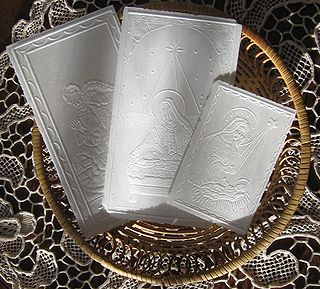 W
WChristmas wafer is a Polish Catholic Christmas tradition celebrated mostly in Poland and also in parts of Lithuania, Latvia and Slovakia during Wigilia on December 24.
 W
WGołąbki is the Polish name of a dish popular in cuisines of Central Europe, made from boiled cabbage leaves wrapped around a filling of minced pork or beef, chopped onions, and rice or barley.
 W
WGoulash is a soup or stew of meat and vegetables seasoned with paprika and other spices. Originating in Hungary, goulash is a common meal predominantly eaten in Central Europe but also in other parts of Europe. It is one of the national dishes of Hungary and a symbol of the country.
 W
WHead cheese or brawn is a cold cut terrine or meat jelly, often made with flesh from the head of a calf or pig, typically set in aspic, that originated in Europe. Usually eaten cold or at room temperature, the dish is, despite the name, not a dairy cheese. The parts of the head used in the dish vary, though commonly do not include the brain, eyes and ears of the animal used. The tongue, and sometimes the feet and heart of the animal may be included; the dish is also made using the trimmings from more commonly eaten cuts of pork and veal, with the addition of gelatin to the stock in order to act as a binding agent. Head cheese may also be made without utilising the flesh from the head of an animal.
 W
WKalduny or kolduny are stuffed dumplings made of unleavened dough in Belarusian, Lithuanian, and Polish cuisines, akin to the Polish pierogi, Russian pelmeni and the Ukrainian vareniki.
 W
WIn the English language, kasha usually refers to pseudocereal buckwheat or its culinary preparations. In various East-Central and Eastern European countries, kasha can apply to any kind of cooked grain. It can be baked but most often is boiled, either in water or milk, and therefore the term coincides with the English definition of porridge, but the word can also refer to the grain before preparation, which corresponds to the definition of groats. This understanding of kasha concerns mainly Belarus (каша), the Czech Republic (kaše), Lithuania (košė), Poland (kasza), Russia (каша), Slovakia (kaša) and Ukraine (каша), where the term, besides buckwheat, can apply to wheat, barley, oats, millet and rye. Kashas have been an important element of Slavic diet for at least one thousand years.
 W
WKibinai, Kybyn; Kibin are traditional pastries filled with mutton and onion, popular with Karaite ethnic minority in Lithuania. As everything Karaite in Lithuania, they are mostly associated with the city of Trakai. English-language travel guides compare them to Cornish pasties. Initially, they come from Crimea from where the Grand Duke of Lithuania Vytautas the Great took Tatar and Karaite families to become their guards in order to thank them for their help during his fight against the Golden Horde.
 W
WKielbasa is any type of meat sausage from Poland, and a staple of Polish cuisine. In American English the word typically refers to a coarse, U-shaped smoked sausage of any kind of meat, which closely resembles the Wiejska sausage in British English.
 W
WKopytka are a kind of potato dumpling in Polish, Belarusian, and Lithuanian cuisines. They are similar to Italian gnocchi and German Schupfnudel.
 W
WKūčios or Kūtės is the traditional Christmas Eve dinner in Lithuania, held on the twenty fourth of December. The meal is a family occasion which includes many traditions of both pagan and Christian origin. Some traditions are no longer widespread and usually Lithuanians just enjoy dinner with relatives and friends while the main events and festivities are left for Christmas Day.
 W
WKūčiukai also called Christmas cakes - is a traditional Lithuanian dish served on Kūčios, the traditional Christmas Eve dinner in Lithuania. They are small, slightly sweet pastries made from leavened dough and poppy seeds. There are variations in sweetness, it is usually eaten dry but can be served soaked in poppy milk or with cranberry kissel. Initially they were made as small loaves of bread served for the spirits - vėlės.
 W
WKugelis, also known as bulvių plokštainis, is a potato dish from Lithuania. Potatoes, bacon, milk, onions, and eggs are seasoned with salt and pepper and flavoured, for example with bay leaves and/or marjoram, then oven-baked. It is usually eaten with sour cream or pork rind with diced onions.
 W
WKvass is a traditional fermented Slavic and Baltic beverage commonly made from rye bread, which is known in many Central and Eastern European and Asian countries as "black bread". The colour of the bread used contributes to the colour of the resulting drink. Kvass is classified as a "non-alcoholic" drink by Ukrainian, Belarusian, Russian, Latvian, Lithuanian, Polish, Serbian, and Romanian standards, as the alcohol content from fermentation is typically low. It may be flavoured with fruits such as strawberries or raisins, or with herbs such as mint. Kvass is especially popular in Russia.
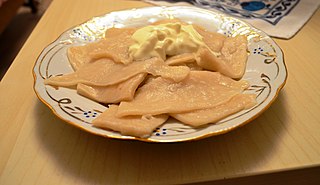 W
WLazanki is a Belarusian, Lithuanian and Polish type of pasta. It consists of wheat, rye or buckwheat kneaded into dough which is rolled thin and cut into triangles or rectangles. These are boiled, drained, and eaten with melted pork fat, vegetable oil and often sour cream. In Poland, they are commonly mixed with fried cabbage or with soured cabbage and small pieces of sausage, meat and/or mushrooms.
 W
WLingonberry jam is a staple food in Northern European cuisine and otherwise highly popular in Central and Eastern Europe. Lingonberries grow on a short evergreen shrub in the Arctic tundra throughout the Northern Hemisphere from Eurasia to North America.
 W
WAn open sandwich, also known as an open-face/open-faced sandwich, bread baser, bread platter or tartine, consists of a slice of bread or toast with one or more food items on top.
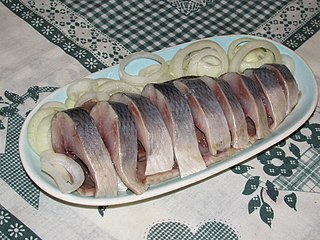 W
WPickled herring is a traditional way of preserving herring as food by pickling or curing.
 W
WPierogi are filled dumplings made by wrapping unleavened dough around a savoury or sweet filling and cooking in boiling water. They are often then pan-fried before serving.
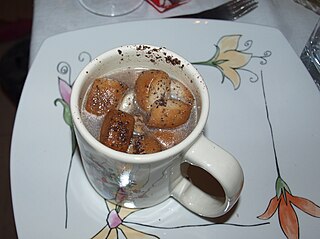 W
WPoppy milk is a traditional Lithuanian drink or soup, one of the 12-dishes Christmas Eve Supper Kūčios. Usually it is eaten together with kūčiukai, another traditional Lithuanian Christmas Eve dish. It is also an ingredient in kutya a meal served during a traditional Ukrainian Christmas Eve Feast. This drink is considered a dessert.
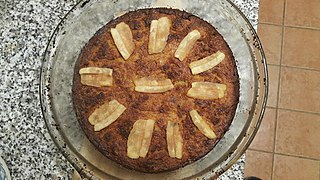 W
WPotato babka is a savoury dish, popular especially in Belarus and Poland, where it is known as babka ziemniaczana. It is made from grated potatoes, eggs, onions, and pieces of smoked, boiled or fried bacon and sausage. It is oven-baked in a crock, and often served with a sauce of sour cream and pork flitch. Depending on recipe and cooking method, it may be either a flaky potato pie or a heavy potato pudding.
 W
WPotato pancakes, raggmunk, draniki, deruny, latkes or boxties are shallow-fried pancakes of grated or ground potato, matzo meal or flour and a binding ingredient such as egg or applesauce, often flavored with grated garlic or onion and seasoning. They may be topped with a variety of condiments, ranging from the savory, to the sweet, or they may be served plain. The dish is sometimes made from mashed potatoes to make pancake-shaped croquettes. Some variations may be made with sweet potatoes.
 W
WRollmops are pickled herring fillets, rolled into a cylindrical shape, often around a savoury filling.
 W
WSkilandis or Kindziukas is a Lithuanian matured sausage made of meat, fat, salt, pepper and garlic. The ground meat is traditionally pressed into a pig's stomach or bladder, but today may be contained in other skins. The sausage is dried and cold-smoked. Skilandis dates back to at least the 16th century - the word skilandis is referred to in documents from various locations across the Grand Duchy of Lithuania as early as in the 16th-18th centuries.
 W
WSmetana is a type of sour cream from Central and Eastern Europe. It is a dairy product produced by souring heavy cream. It is similar to crème fraîche, but nowadays mainly sold with 9% to 36% milkfat content depending on the country. Its cooking properties are different from crème fraîche and the lighter sour creams sold in the US, which contain 12 to 16% butterfat. It is widely used in cooking and baking.
 W
WSushki are traditional Eastern European small, crunchy, mildly sweet bread rings eaten for dessert, usually with tea or coffee.
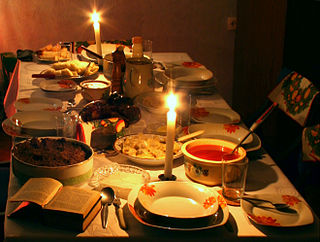 W
WA twelve-dish Christmas Eve supper is traditionally prepared to commemorate Jesus' twelve disciples in Central, Northern and Eastern European cultures, especially those that were formerly part of the Polish–Lithuanian Commonwealth and neighbouring countries. The tradition is especially cultivated in modern-day Poland, where alternatively thirteen meatless dishes on Christmas Eve are sometimes served.
 W
WZrazy is a meat roulade dish popular in Poland, western Belarus and Lithuania. Its origin can be traced back to the times of the Polish–Lithuanian Commonwealth.